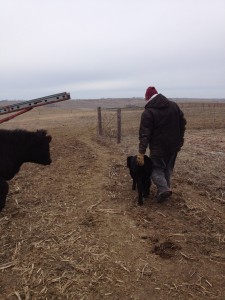CommonGround Volunteers Show How Farming in the Snow Is No Cake Walk
Posted: February 22, 2013
Most consumers associate the cold, wintery weather that swept the country this week with staying indoors and keeping warm. Envisioning farming as a sunny day, warm weather gig, they often forget that farmers work to care for their land and livestock 365 days a year.
As snow and ice reign down on the roads, keeping kids home from school and adults stuck in traffic, many farmers are also vigilantly protecting their farms and their animals from the dangerous conditions.
Today, Corn Commentary features a guest blog post and a letter to the editor penned by CommonGround volunteers about how they care for cattle when the temperatures drop. Consumers worried about animal welfare can take heart. These farm women are taking action out of concern for their cattle, just like farmers across the country.
First, Sara Ross, a CommonGround Iowa volunteer, walks blog readers through what her and her husband do to prepare for a winter storm.
Preparing the Cattle for the Big Snowstorm
Everyone’s been talking about it all week…the big snow storm. First it was suppose to start Wednesday night then it got pushed back to Thursday morning then Thursday around noon. I’ve heard anywhere from 6-18 inches of snow forecasted. Normally it would be all fun and games to be snowed in, but since we have cattle, we had to get them prepared for the storm.
Kevin wanted to move the cows from across the road, where they were out on cornstalks, to our side of the road where they would have more protection and be easier to feed and water. We are a few weeks away from calving, but you never know when a big snow storm hits what will happen!
So, first thing this morning Kevin and I headed outside to get the cows moved to our side of the road.
To read the full post, click here.
CommonGround Nebraska volunteer Joan Ruskamp, who is well familiar with many of the questions consumers have about farming in the winter. She penned the editorial piece below To help answer questions she had seen in local papers.
Baby, it’s cold outside…but there’s still plenty to do on the farm
About this time every year, I begin to get surprised looks from people when I talk about all the activities happening on my family’s farm near Dodge, Neb. Together with my husband, we feed cattle and raise corn, soybeans and alfalfa. While the crops may not require a great deal of attention in the winter months, animal care on our farm is a top priority 365 days a year.
One of my many responsibilities includes walking through the cattle every morning, no matter the weather conditions, to make sure each animal is healthy. If an animal is sick and needs to be treated with antibiotics, we always adhere to label use under the supervision of our veterinarian. We also adhere to strict withdrawal times, or a set number of days that must pass between the last antibiotic treatment and the animal entering the food supply. And even though cattle have hair coats designed to handle living outdoors, in the cold winter months, we take extra care to make sure they are as comfortable as possible.
We provide extra bedding and windbreaks to help block the extreme cold. And in addition to shoveling our driveway during a snowstorm, we must remove or pile snow in the pens so that the cattle have dry places to lie down. We also must make sure that even during a snowstorm; the cattle are fed at their normal times with continuous access to water.
So, even though the winter weather might make you want to stay bundled up inside, know that farmers are braving the elements to make sure the animals are well cared for - because healthy animals equal healthy food for our families.
Sincerely,
Joan Ruskamp, farmer, Dodge, Neb.





